#dungeons and dragons resources
Text
I made a D&D Discord server!
It includes links to the free templates and some other resources I use, and a link to a hypothetical D&D Beyond campaign that has content sharing on that you can hypothetically join with characters and use people’s purchased books without buying them for yourself. (More info on how in the discord, the more people who join the better this will work!)
I also have an artist corner so people can commission artists for artwork, and for artists to advertise their commissions!
When you join, introduce yourself in the introductions channel and you will be granted access to the rest of the server! Be sure to read the rules as well 💕
#dnd#dungeons and dragons#d&d#dnd character#dnd resources#dm resources#dnd discord#dungeons and dragons discord#dungeons and dragons resources#discord
95 notes
·
View notes
Text
How to cook in a medieval setting
Alright. As some of the people, who follow me for a longer while know... I do have opinions about cooking in historical settings. For everyone else a bit of backstory: When I was still LARPing, I would usually come to LARP as a camp cook, making somewhat historically accurate food and selling it for ingame coin. As such I know a bit about how to cook with a historical set up. And given I am getting so much into DnD and DnD stories right now, let me share a bit for those who might be interested (for example for stories and such).
🍲Cooking at Home
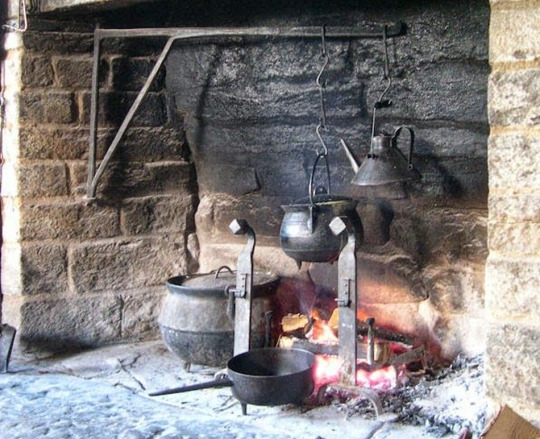
First things first: For the longest time in history most people did not have actual kitchens. Because actual kitchens were rather rare. Most people cooked their food over their one fireplace at home, which looked something like what you see above. There was something made of metal hanging over the fireplace. At times this was on hinges and movable, at times it was set in place. You could hang pots and kettles over it. When it came to pans, people either had a mount they would put over the fire or some kind of grid they could easily put into place there with some sourts of mounts (like the two metal thingies you can see above).
If you have a modern kitchen, you are obviously used to cook on several cooktops (for most people it is probably four of them), while in this historical you obviously only had one fire. Of course, as you can also see in the picture above, you could often put two smaller pots over the flames or put in a pan onto the fire additionally. But yes, the way we cook in modern times is very different.
Because of this a lot of people often ate stews and soups of sort. You could make those in just one pot - and often could eat from the same stew for days. In a lot of taverns the people had an "everything stew" going, which worked on the idea that everyone just brought their food leftovers, which were all put into one pot everyone would eat from.
Now, some alert readers might have also noticed something: What about bread and pastries? If you only have one fireplace and no oven, how did people make bread?
Well, there were usually three different methods for this. The most common one was communal ovens. Often people had one communal oven in a neighborhood. Especially in a village there might just be a communal oven everyone would just put their bread in to bake. (Though often this oven would only be fired up once or twice a week.)
The second version to deal with this some people used was a sort of what we today call a dutch oven. A pot made either of metal or clay with a lit you would put into the hot coals and then put bread or pastries into that, baking it like that.
There was also a version where people just baked bread in pans on the fire, rotating the bread during the baking process. At least some written accounts we have seem to imply. (Never tried this method, though. I have no idea how this might work. My camp bread was mostly done in dutch ovens or as stickbread.)
Keep in mind that the fireplace at home was very important for the people in historical times. Because it was their one source of warmth in the house.
🏕️ Cooking at Camp

Technically speaking cooking at camp is not that different - with the exception of course that you have to drag all your supplies along. And while in Baldur's Gate 3 and most other videogames you can carry around several sets of full-plate armor and several pounds of ingredients so that dear Gale can whip something up... In real life as an adventurer running around you need to make decisions on what to take along.
If you have read Lord of the Rings, you might remember how many people have criticized Sam for actually dragging all his cooking supplies along and how sad he was for not being able to cook for most of the time, because they were very limited in taking ingredients along.
So, yes, if you are an adventurer who is camping out in the open, you will probably need to do a lot of hunting and gathering to eat during your travels. You can take food for a couple of days along, but not for a lot.
A special challenge is of course, that while you can cook food for several days when you are at homes, you do not want to drag along a prepared stew for several days. So usually you will cook in smaller batches.
A lot of people who were journeying would often just take along one or two pots along.
So, what would you eat as an adventurer travelling around while trying to save the world from some evil forces? Well, it would depend on the time of the year of course. You would probably hunt yourself some food. For example hares, birds or squirrels. Mostly small things you can eat within one or two days. You do not want to drag along half a dead deer. In the warm months you might also forrage for all sorts of greens. You also can cook with many sorts of roots. Of course you can also always look into berries and other fruits you might find.
Things you might bring with you might be salt and some spices. A good thing to bring along would be herbs for tea, too, because I can tell you from experience that water you might have gotten from a river does not always taste very well - and springs with fresh water are often not accessible.
Now, other than what you can access the basic ideas of camping fires and cooking with them has not changed in the last few thousand years. While modern people camping usually have a car nearby and hence will have access to a lot of ingredients. But the general ideas of how to build a fire and put a pot over it... has not really changed.
So, yeah.
Just keep in mind that for the most part in historical settings until fairly recently, there was not much terms of proper kitchens. People cooked over an open fire and hence had to get at times ingenius about it.
#dungeons & dragons#baldurs gate 3#lord of the rings#medieval europe#medieval#cooking#medieval cooking#food history#historical settings#history#european history#writing#fantasy#writing resources
1K notes
·
View notes
Text
Ditching D&D Beyond or never got it in the first place? Here's some free/pwyw resources.
Dicecloud. This online app allows you to make and track character sheets for free! It does a lot of the calculations for you, just like dnd beyond would. Best overall replacement. (Thank you, @chryslerisdead)
PWYW Class Character Sheets by Emmet Byrne. These character sheets in my opinion, are easier to fill out and harder to mess up, with class-specific features built-in. You can easily edit them digitally, and there's even multiclass/homebrew options. Slap em on Google drive or something, share with your DM, lots of options.
Point-Buy Calculator. Easily automates character stat creation if you're using the Point-Buy system.
5e Level Up Tool. Select your class, select your level, get a digestible checklist of everything you need to do to level up. This one is SO GOOD and so slept on.
5e Spellbook. A quick way to reference your spells and build a Spellbook with a ton of filters.
Encounter Calculator. I know challenge rating isn't everything, but this is a good/fast way to see how balanced your encounters are, at a glance, at least in the eyes of the source books.
RPGbot. Lots of resources for DMs and players: encounter builders, dpr calculators, and lists of player options with sample builds and optimization suggestions, which may be helpful to folks new to the game.
Bonus: Online Tools (System Agnostic)
Here.fm. This is the alternative I use instead of roll20, because it's faster/easier. Drag and drop in maps and tokens in seconds, built-in library of stickers you can use for effects, draw right on the virtual tabletop, use temporary drawings to map out moves, built-in dice rollers, and options for proximity chat. I use it in combination with discord (just have players join your here room muted), but it could be used entirely on it's own, I imagine. Not built for ttrpgs, but works incredibly well for them.
Kenku.fm. A PWYW mini browser focused on mixing and sharing music to your dnd games through whatever app you use, with helpful discord support. This app also LEGALLY bypasses the issue that got all the YouTube discord bots shut down, so you can share YouTube audio worry-free.
Additional Resources (Aka, stuff I found out about after I originally posted this):
flapkan. Holy shit, this might be the BEST character sheet option on this list! Form-fillable pdfs with fully automated built-in prompts to auto fill features and spells, built-in Point-Buy and other automated calculations, and it generates a lot for you. Can be used digitally or you can print!
#d&d beyond#dnd beyond#dnd resources#5e#dungeons and dragons#roll20#nyklos is typing#resources#also if you need the books and are ok with being a little jolly-rodger-core just add pdf to the end of your google search#oops! fixed typo in kenku.fm
3K notes
·
View notes
Photo
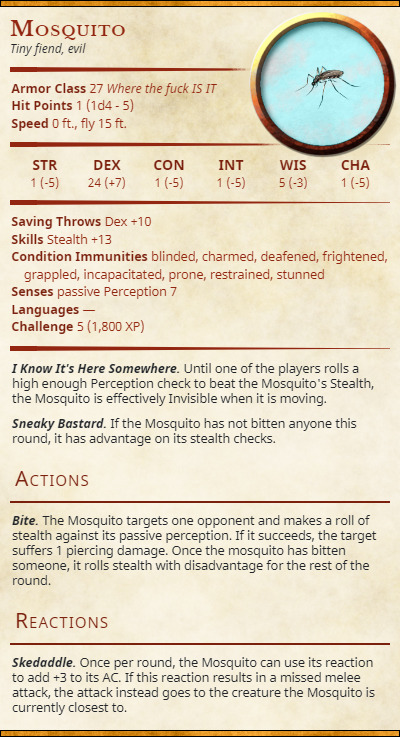
Tired of your players killing all your monsters? Set this on them. Bonus points if you make the tiny mosquito tone buzz every time one of them rolls juuuust below the required Perception DC.
I don’t know why I made this
19K notes
·
View notes
Text
Curated Spotify playlists to liven up your D&D sessions!
I have always loved playing D&D with background music that fits the location, mood, or type of combat, so I created several playlists on Spotify. This project is something I've been working on since December 2019, and something I want to share with you all! You can find the list below.
If you have suggestions for songs/tracks to include, or if you want a specific playlist that is not in this list yet, please let me know! And most of all, have fun!
Locations
Astral Plane
Ball/Masquerade
Bazaar
Castle/Court
City
Desert
Dungeon
Festival
Forest
Jungle
Monastery
Mountains
Schools of the Arcane
Ship
Tavern
Temple
Town/Village
Underwater
Moods
Creepy/Eerie
Dramatic
Enchanted
Energetic/Adventurous
Heroic
Grand
Intrigue
Menacing
Mysterious
Night
Peaceful
Sad/Mourning
Silly
Tender/Emotional
Combat
Small Battle
Big Battle
Boss Battle
Tavern Brawl
Chase
Themes/settings
Ancient Greece
Bard songs
Patrons/Visions
Visions/Dreams
#dnd#dnd 5e#ttrpg#music#spotify#playlist#writing#writing inspiration#spotify playlist#d&d#dungeons and dragons#worldbuilding#dm tools#resources#reference
1K notes
·
View notes
Text
Attention fellow Galemancers, I found something extremely relevant to our interests in The 5E Guide to Sex sourcebook:
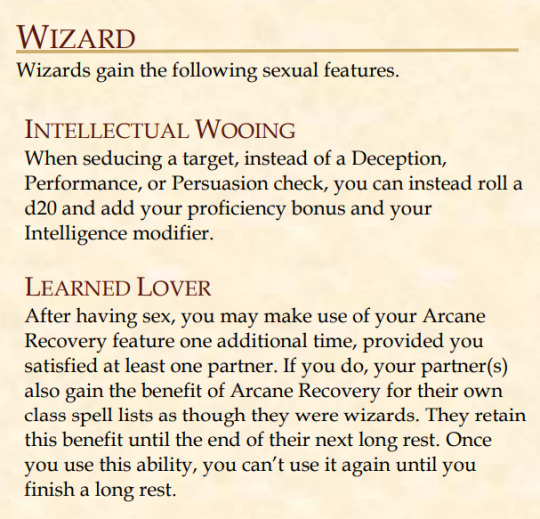
We definitely gotta start incorporating "Gale made me come so hard it restored my spell slots" into our headcanons and fanfics.
#hornyposting#live from the Gale Dekarios Sex Research Institute#BG3#Baldur's Gate 3#Gale#Gale of Waterdeep#Gale Dekarios#Gale BG3#BG3 Gale#I love him so much#fanfic authors pls#bg3 fanfic writing resources#5E Guide to Sex#Dungeons & Dragons#D&D#DnD
659 notes
·
View notes
Text
d&d player asks
FOR THE PLAYER
Race: What's your favorite race to play? Is there a race you default to or play more often?
Class: What's your favorite class to play? What's your favorite character build you've ever played?
Playtest: What class (or subclass) do you want to try out?
Party Comp: Do you think about party composition while building a character? What role do you usually fill in your party, if any?
Level One: What was your first experience with D&D? How did you hear about it? What was your first game like?
Skill: Do you prefer RP, combat, or something else? Is there a part of the game you consider yourself best at?
Scheduling: Do you prefer to play in long campaigns, oneshots, or something in between?
Feat: What's one habit, trick, tip, etc. you picked up from another player?
Nat 20: What's the most memorable RP scene you've been a part of?
Initiative: What's an RP scene you're looking forward to playing?
Crit Fail: Have you ever had a character death? What happened?
Diamond: Have you ever participated in a character resurrection (for your own character or someone at the table)? What happened?
Backup: Do you design backup characters? What's your process? Have you ever had to use one?
Dungeon Court: What's the worst D&D experience you've ever had?
Dice: Do you have any dice rituals? Preferences? Collections? Does such thing as dice luck really exist?
FOR THE DM
Leveling: What's your ideal starting party level? What leveling system do you use? What level is your current (or most recent) party?
Prep: How much prep work do you do? How far out do you prep?
Screen: What do you usually keep behind your DM screen?
TPK: Have you ever had a game go completely off the rails? TPK? How did you adjust?
Session Zero: Is there anything specific you ask your players to have before you start playing (e.g. a secret about their character, a backstory event, etc.)?
Homebrew: Do you have any house rules or homebrews you use? What are they?
FOR THE CHARACTER
(A/N: You may want to specify a character for these!)
Background: Does your PC get up to anything that you don't narrate often? Any background habits, activities, plots? Do you share these through other avenues (e.g. a group chat, table cross-talk, posting online)?
Vibe: How does your character get along with the party? Does your group talk about party dynamics outside the game?
Downtime: What does your character do in their downtime? How do you bring this up during gameplay?
Secret: Is there anything that you know about your character but your character doesn't know? What is it? How did you come up with this secret?
Heart: What drives your character? Do they have a theme, question, mission, etc. that they're holding onto? How did you pick it for them?
End: What's the ideal ending for your character's story and the game? Are these the same, or different?
#dungeons and dragons#ask meme#ask prompt#ask game#meme resources#meme resource#ttrpg memes#dnd#also taking these btw#mine; meme resource#mine; ask game#mine; ask meme
335 notes
·
View notes
Text



This large catamaran could make a suitable vessel for an adventuring party or an encounter as an exploration vessel or merchant. She measures 100 feet in length and 70 feet in width, is modestly armed with two ballistas, and her dual tumblehome hulls and shallow draft result in a stable, comfortable vessel. Two smaller boats are carried onboard and launched via cranes for shore excursions.
The upper deck hosts a deckhouse which contains the ship's galley, mess, and officers' wardroom, & captain's quarters. The lower deck in each hull contains cargo holds and sleeping quarters (including private, but spartan, accommodations for junior officers).
Full size PNGs and VTT files are available on my Patreon without watermark, in night/day + grid/gridless variants.
#D&D#dungeons & dragons#dnd maps#roll20#ttrpg#ttrpg community#dungeondraft#nautical#DM resource#Tellus#catamaran
85 notes
·
View notes
Text
Hello, everyone! Here are my "Notes from The Alexandrian", a (currently 69-page, nice) living document that compiles basically what I consider the "best of" from various TTRPG sites into an ADHD-friendly, outline-laden resource that compresses and summarizes everything into its bare essentials, bullet-point style.
Inside you will find a plethora of easy-to-digest ways to improve your DMing and GMing that are relatively system agnostic. If you find this document useful, please feel free to reblog it and share it with friends. If you have thoughts to add, comments are open, feel free to leave some.
Thanks!
242 notes
·
View notes
Text


Another set that was finished and uploaded a little while ago, these are the Ocular Swarms! This mini was made to serve as an accompaniment to the larger Ocular Anomaly shown previously, and to function as some smaller swarm mobs to pad out the encounters a bit more. Therefor these match well with their larger counterparts both in color and design. A closer look at the colors is coming next in a separate post!
If you like what you see and want to support me and get a whole bunch more printable minis like these, check out my Patreon page! All of them come in, pre-scaled easy to print PDFs / PNG files and work great with a myriad of ttrpg games, including DnD, Pathfinder, Daggerheart, Blades in the Dark, Call of Cthulhu and more. The front view for most minis is FREE and supporters get access to a whole lot more including unique back views, color options, alternative poses & variant designs, VTT tokens and so much more. With dozens of minis to choose from, and more uploading every month, you will always have a new option for your table. ❤
#d&d#d&d 5e#dnd#dungeons and dragons#art#artists on tumblr#d&d miniatures#miniatures#dnd miniatures#paper miniatures#printable miniatures#dnd minis#illustration#dnd community#dnd art#dnd resources#ttrpg#ttrpg community#ttrpg mini#ttrpg art#worldbuilding#dnd5e#dungeon master#pf2e#dnd artist#dnd monster#creature art#horror art#call of cthulhu#monster art
39 notes
·
View notes
Text
Hey all, This is my first Tumblr post ever! I'm pretty new here, but I'm hoping to share some DM techniques, tools and tips and to make some new friends as well! Feel free to send a chat request (an ask[?]) if you're interested!
With that aside, on with the post!
Better and More Meaningful Random Encounters!
Random encounters are a staple of DnD, they are expected to be there during exploration as a way to make the world feel alive, to have it have an aura of adventure and danger, to eat up party resources and put pressure on the PCs to make interesting and important choices, and also as a way for a DM to reasonably 'stall' the party with a quick and easy situation.
Usually, it ends up something like this:
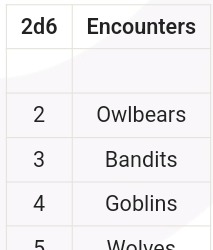
There's just one problem with most random encounter tables though, it's so easy for them to be GOSHDARN BORING! Especially for a newer DM.
Making them interesting becomes gambled improv on the DM's part if they're not used to it, and it's hard to keep track of the important factors that need to be kept in mind
Luckily, I ended up finding a great source for random encounters from 'Dungeon Masterpiece' on YouTube, and I integrated it into my own DMing. I figured that I'd share it here for any that want to work it into their own sessions as well!
After adjustment, a single table can account for multiple entire sessions of in-depth worldbuilding and fun without getting dull!
Sources:
Source 1 (Creating interesting Random Encounter Tables):
youtube
Source 2 (Making Random Encounters reflect your Worldbuilding):
youtube
There's 4 major methods we can use to improve the Random Encounter table
1. Make the table a straight 1dx roll.
2. Adding 'depth'.
3. Adding meaningful encounters.
4. Prerolling and/or Multirolling.
You can also check out the "Where to Start?" section for some direction to make getting it down and prepped all easy peasy!
1. Straight Roll:
Its enticing to go for 2d6 or the such in order to add non-linearity to the rolls, but these sorts of adjustments only end up making one or two encounters extremely likely and leave all others in the dust, it often ends up defeating it's own purpose of interesting randomness.
In the previous example, it was extremely likely to only get Wolves, Barbarians, Orcs, or Spiders, from a table of 12! A straight roll would serve us much better. The rare rolls are already rare enough as is!
Simply enough, adjusting the original example by replacing the 2d6 with 1d12, it'd become something more like this:
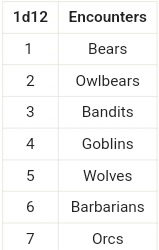
#2. Adding Depth:
We can add more columns in the encounter tables. These columns will represent different aspects about the encounters that we can roll on separately!
Usually it can be difficult as a DM to naturally come up with motives for the encounters, showcase the worldbuilding and have it all come together.
This setup can give you a solid guideline on how the creatures/people think (if any), and also sets up the overall area so that you get an idea of what events tend to occur there as a result of its occupants.
We want to add 3 more columns to the tables to convey different aspects of the encounter. Fill in these new columns corresponding to the expectations of each encounter.
We'll roll each of these and combine them, then we'll interpret them to make a robust, in-depth random encounter with truly unexpected results!
I recommend rolling alot of complete encounters at once and interpreting the context to the vast general area the party is travelling in.
i. Behaviour: How the creatures act. Are they friendly, scared, aggressive, curious, mischievous?
ii. Complication: Something behind the scenes in the encounter. Do they have sick young? Broken equipment? Are they starving?
iii. Significant Impact: This is a tick box, and will only be present under ONE of the rows. It will be rolled like the other columns, but ONLY once. It signifies which encounter is the Significant Encounter
The Significant Encounter will have its encounter's presence prominent amongst all the other random encounters in the area. There could be burn marks and carcasses from a rampant dragon, or a goblin raid leaving tracks moving through the area. Which is the most impactful of the different encounters?
Adding this to our previous example would expand it to:

Rolling this would give us things like:
Significant encounter: Owlbears

Note that the significant impact shows that the Owlbears are a massive problem in the area. Perhaps the Owlbears are agitated for an unknown reason, and are unnecessarily aggressive.
The significance of Owlbears gives us context to the second one as well! Perhaps the hunters raided an Owlbear den, and adopted an Owlbear cub from there as well.
There could be uneaten carcasses, ravaged trees, less wildlife, etc around these parts.
Note how much sheer CONTEXT these columns add to our encounters. It's invaluable!
3. Adding Meaningful Encounters
Usually random encounters tend to be rather mundane and very one-note.
There's usually some general wildlife and monsters, different disparate factions without any rhyme or reason, and maybe a general non-combat encounter or two, but these don't really tell us about the area or its surroundings at all by themselves.
Instead, we can add in wildlife and monster encounters specific to the biome, non-combat encounters, and encounters of nearby factions and/or settlements to the table, and we can even add environmental encounters in there as well.
Note that we're not tied down to 12 encounters, and can expand it ad infinitum according to our need of diversity in our encounters.
Just add in specification and connection, and suddenly the dominos all fall into place.
Lastly, we'll also be adding in 'DOUBLE TIME' which will let us roll on everything twice, and make it so it's a double encounter!
Thus, the table can instead be adjusted to:
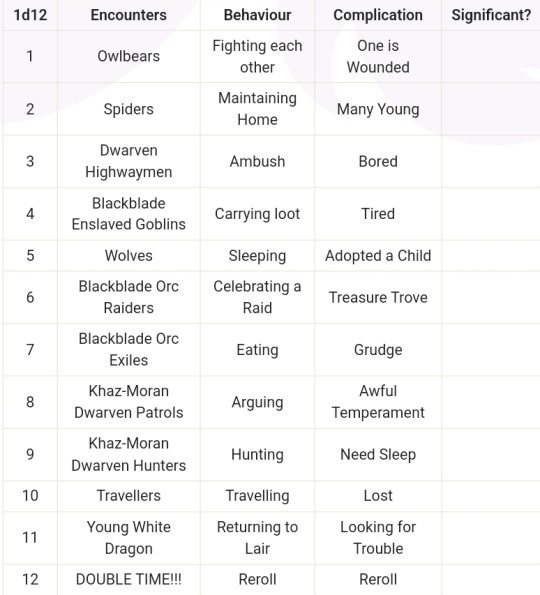
Note how each and everything has its relation in one way or another, but through the sheer variance, they remain truly random and novel.
4. Prerolling and/or Multirolling
Lastly and this is just something that I do, but that I found gamechanging. Be sure to pre-roll 5-7 encounters for each session, for the general area the players are going to be headed in.
Note that you don't need to really prep anything at all, just interpret all of them on a surface level as a buffer.
Also note that you don't need to use all of them if they're not needed. The foreshadowing and signs are worldbuilding and having secrets that the players don't unravel is just as useful as the ones that they do, perhaps even moreso. It adds depth and detail beyond the scope of what the party will encounter
It simply let's you get an idea of the connections between encounters, allows for foreshadowing, and acts as a deterrent to getting caught off guard.
Even if you roll mid-session, I recommend calling for a 5 minute break, rolling 5-7 encounters at the same time and interpreting them and their connections before resuming the session.
It WILL make a difference, trust me
Where to start?
It can be difficult getting inspiration or direction to get started in creating these random encounters, and sometimes you don't want to go through the hassle of thinking them up from nothing
For some great conceptual headstarts and examples for these tables, you can check out 'Worlds Without Number' and it's:
- Page 205 (Great general templates for encounters differentiated by broad creature types such as Beasts and Monsters, Sapient Monsters, and Humans)
- Pages 206-219 (For inspired locations to occasionally run rare encounters or groups of encounters in. This works best with flexible/discovered worldbuilding given the significance of some of these, and you also want to add these in sparingly to keep them significant)
- Pages 246-247 (These pages have great templates for the kinds of encounters and situation to be included in the tables, and it can be expanded vastly, and certain options can be selectively and repeatedly chosen to meet our needs. Mood works well as a complication.)
There might be other pages that are useful as well for these sorts of random encounters in the wilderness that I haven't come across yet. If so, give them a shout out and I'll be sure to add them in. It's worth checking it out in its entirety for some great tips!
Conclusion
Again, credit goes to Dungeon Masterpiece and Worlds Without Number for excellent adjustments. This has been quite long, but I hope you stuck around till the end.
Many a session have been made easy but complex ever since this was introduced and I hope that this helps you out as much as it helped me in my prep and improv!
Feel free to give any advice in formatting on Tumblr, or any feedback on the post itself. It really means a lot to me, thanks!
#dm tools#dungeons and dragons tips#dungeon master tips#dm advice#dm tips#ttrpg#dnd#Youtube#dnd resources#gm tips
58 notes
·
View notes
Text
What's your favourite map-making tool?
#Dungeon Master#Game Master#Resource#Tool#Map Making#Map#D&D#DnD#Dungeons and Dragons#World building#TTRPG#Tabletop#RPG#Roleplaying Game
131 notes
·
View notes
Text
Corruption
I was struck with inspiration as I lay in bed last night. I'm gonna write it as a rule for dnd 5e but the concept could be adapted to similar games easily.
The basic idea is to sometimes replace damage with Corruption Dice (spooky), which are subtracted from d20 rolls and sometimes cause surprise damage.
(plain text is rules jargon, purple text is me saying stuff)
Concept:
This mechanic is meant to emulate various forms of magical curses as an alternative to damage. In my head it's something that can be inflicted on players if you want to create a sense of impending doom without just damaging them.
It adds a numeric way to simulate indirect harm that spooky things might cause. Just damage can get boring so this is something to heighten vibes and force players out of their comfort zone. The intended effect is to make players feel like something bad is coming, or like they're being forced by some supernatural energy to accept harmful consequences.
Added bonus is that it can mitigate insane modifiers that high level players end up with.
Mechanics:
Corruption is inflicted on characters (or creatures generally) as a number of dice. These dice are not rolled but are added to a pool. For example, if a creature takes 3d6 corruption, add 3d6 to their total corruption and don't roll them (this could be a written tally or a kept as a pile of dice in front of the player). A creature with a non-zero amount of corruption is referred to as corrupted.
This pool of dice remains until spent, or until removed by the lesser restoration spell or any effect that removes curses. Whenever a corrupted creature makes an attack roll, ability check, or saving throw, they can spend some of it by rolling a number of corruption dice and subtracting the total from the initial roll. When they spend corruption in this way, they cannot spend more than 3 dice on any given d20 roll.
Alternatively, a corrupted creature can spend up to 3 corruption dice during a short rest, roll them, and take damage equal to the total.
When a corrupted creature makes an attack roll, ability check, or saving throw and rolls a natural 1, they must immediately spend all of their corruption dice at once. When the dice are spent in this way, they deal necrotic damage to the corrupted creature equal to the number rolled.
Implementation:
Corruption can be quickly inserted as a replacement for damage. It can appropriately be inserted into the spells or abilities of fey, fiends, or undead. One use I would recommend would be to use it instead of damage for magical traps or include the mechanic when designing cursed magic items. For a direct conversion, consult the following table:
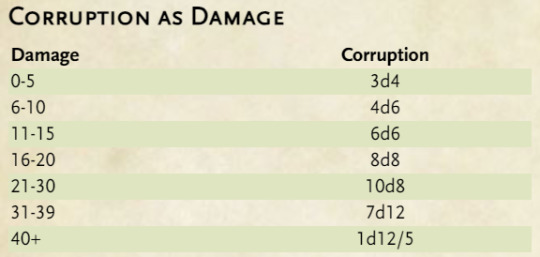
If this makes it more complicated than necessary, or you don't want to mix types of dice, just do 2d6 for every 5 damage.
Lair/Legendary Actions:
This is a good place on a stat block to sub in or add corruption. In addition to damage conversion, you may replace any condition caused by a special action (such as frightened or paralyzed) with a number of d12s equal to the challenge rating of the creature. If you wish to make a creature more powerful, choose one or two of these actions and add d6 corruption/CR to the existing effects (allowing a wisdom or charisma save to avoid it if you want).
Regional Effects:
Unhallowed land, the shadowfell, the territory of a cursed or undead creature, or the domain of an illegitimate ruler may all be places where corruption permeates the air and soil. Use it when it feels right or for a specific antagonist or faction if you want them to have a unique flair. When a creature finishes a long rest in a corrupted place, they must make a DC 15 Charisma saving throw. On a success, the creature feels a vague sense of unease but suffers no other effects. On a failure, the creature gains 2d6 corruption.
If the source of the corruption is a sentient creature, they can choose up to 13 creatures that they know to be within the affected area. When any of those creatures fails their saving throw, they instead gain 1d12 corruption for each night they have spent in the affected area.
Monster Traits:
Following are a few example traits that use corruption. They can be added to the statblocks of appropriate creatures. Alternatively, they can be used as identifying features of all creatures in a specific faction or from a specific place.
Aura of Evil. Any creature that starts its turn within 10 ft. of [this creature] must succeed on a DC [8 + proficiency + Cha or Con] Charisma saving throw or gain 1d12 corruption.
Corrupted Strikes. [This creature]'s weapon attacks are magical. When [this creature] hits with any weapon, the target gains 1d8 corruption. A creature immune to necrotic damage or curses is immune to this effect.
Foul Magic. Any creature that fails a saving throw against a spell cast by [this creature] also gains 1d8 corruption. A creature immune to necrotic damage or curses is immune to this effect.
Tainted Blood. A creature that touches [this creature] or hits it within a melee attack while within 5 ft. of it gains 3d6 corruption.
Items:
Below is a single example magic item, to show the way this mechanic could be used to represent curses.

I think it's neat because the ability to use corruption to your advantage encourages a player to seek out dark and dangerous situations. It makes corruption a little less scary, but it uses the meta to push the character to find opponents to inflict it on, lest they suffer the consequences of their actions.
Narrative:
In darker campaign settings, corruption can be used in roleplay to underline thematic elements. The DM may inflict 1-3d8 corruption on any character who gives in to dark desires, betrays someone's trust, does something impious or blasphemous, or witnesses something grim and horrifying.
The DM and players should decide ahead of time exactly which actions or events will lead to corruption, and how severe they have to be to incur a given number (or size) of dice. Consider which type of roleplay you all want to encourage, and which themes should be emphasized.
Player Options:
Spells and abilities that deal damage can easily be converted, either on a character by character or spell by spell basis. Spells that this change would be most appropriate for include arms of hadar, blight, chill touch, cloudkill, dissonant whispers, summon celestial, summon undead, toll the dead, etc.
You could also modify (or make up!) class features so that they inflict corruption instead of damage, or in addition to other effects. A vengeful Cleric's Channel Divinity might inflict corruption upon sinners, even a Rogue's sneak attack might inflict supernatural woe in place of additional damage.
If you, as the DM, allow players to cause enemies to gain corruption, remember that you should spend it more liberally than a player might. You can and should roleplay as that monster or enemy, but consider that a creature that will likely not survive the fight may make the players feel cheated if it never chooses to suffer the penalty.
Variants:
The damage type that corruption deals could easily be changed to highlight different themes. Change it to psychic damage for a more horror or lovecraftian setting, change it to poison damage it you are using it to represent toxic substances or diseases. Perhaps you want to use it to represent radiation poisoning, in which case it could be radiant damage (if not poison or necrotic).
Another idea I like is to make the corruption represent horrible luck. Because the damage is triggered by natural 1s, the DM can describe it as a consequence of some kind of accident and declare an appropriate damage type. For example: a character that rolls a natural 1 on an attack may fall on their sword and take piercing damage equal to their remaining corruption, or a natural 1 on the Constitution save triggered by a green dragon's breath may represent a character gasping and breathing in additional poison damage like an idiot.
Another change, for a more sword and sorcery setting, could include allowing spellcasters to accumulate corruption in exchange for more potent magic. Whenever an arcane caster casts a spell, they may gain 1d12 corruption and increase the level of the spell by one without expending a higher level slot. This could also be a mandatory feature, to make all magic a form of dark bargaining.
This has not been play tested so you may also find it necessary to balance it by including maximum corruption (perhaps dealing its damage if it reaches that threshold), limiting it to d6s or even d4s, or making it less deadly. If the potential damage seems too high, random, and/or disruptive to combat balance, it could be spread out. To do so, change it so that each time a corrupted creature takes damage, they spend one die and add it to the damage.
#dnd#dungeons and dragons#dnd 5e#homebrew#dnd homebrew#game design#ttrpg#ttrpg resources#first post#dark fantasy#fantasy
84 notes
·
View notes
Text

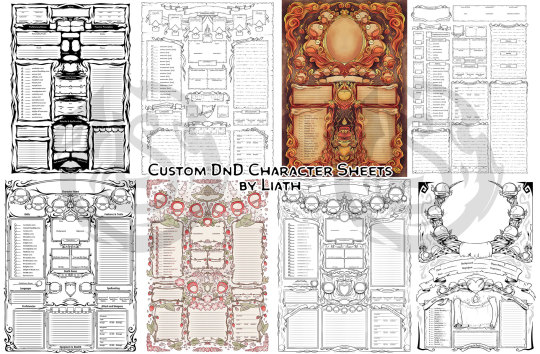
Feels so good to see all the main pages of my character sheets put together. Though it does make me realize I can move on from printer-friendly and try making some with more color. xD
For anyone interested, I have a Patreon for exclusive ones, or you could find a few sets on my Gumroad or Ko-Fi, some are free too!
I still haven't decided on the next theme, I was thinking maybe cute little goblins, kobolds, or perhaps a sea or map theme. Any suggestions?
#my art#myart#dnd#dungeons and dragons#digital art#dnd resources#homebrew#custom#character sheet#5e#d&d#store#patreon#free
102 notes
·
View notes
Text
It's a good thing that Gale got out of Waterdeep when he did, because that city has been going through it. Excerpts from the Forgotten Realms wiki page about the year BG3 is set in:
A conflict between the Xanathar's Thieves' Guild and the Zhentarim in Waterdeep escalates into a street war.
A skirmish between members of the Zhentarim and the Gralhund family becomes known by Waterdhavian broadsheets as the Gralhund Villa Bloodbath.
A clone of Manshoon appears in Waterdeep and strives to exert control over the local Zhentarim from his base at Kolat Towers.
Waterdeep's City Watch is overwhelmed by violence throughout the city, leading to factions stepping in to help fight gangs and monsters, including the Emerald Enclave, the Harpers, the Lords' Alliance, the Order of the Gauntlet, and even the Zhentarim.
The Burnt Tongue Cult begins kidnapping travelers along the Trade Way between Waterdeep and Daggerford.
The ghost of a girl named Sarah manifests in Candlekeep alongside her journal, which seems to detail disturbing information about Lord Viallis Yellowcrest of Waterdeep.
A young bronze dragon named Zelifarn takes up residence in the Waterdeep Harbor.
Dagult Neverember sends agents to Waterdeep in hopes of reclaiming the half a million gold dragons he embezzled during his tenure as Open Lord.
Gale finally returns home from his adventure and his mother's only response to his tale of woe is that he'd picked a good time to take a vacation because the city has been positively dreadful while he was away.
#BG3#Baldur's Gate 3#Gale#Gale of Waterdeep#Gale Dekarios#Gale BG3#BG3 Gale#Forgotten Realms#Waterdeep#dungeons & dragons#dungeons and dragons#dnd#d&d#bg3 fanfic writing resources
375 notes
·
View notes